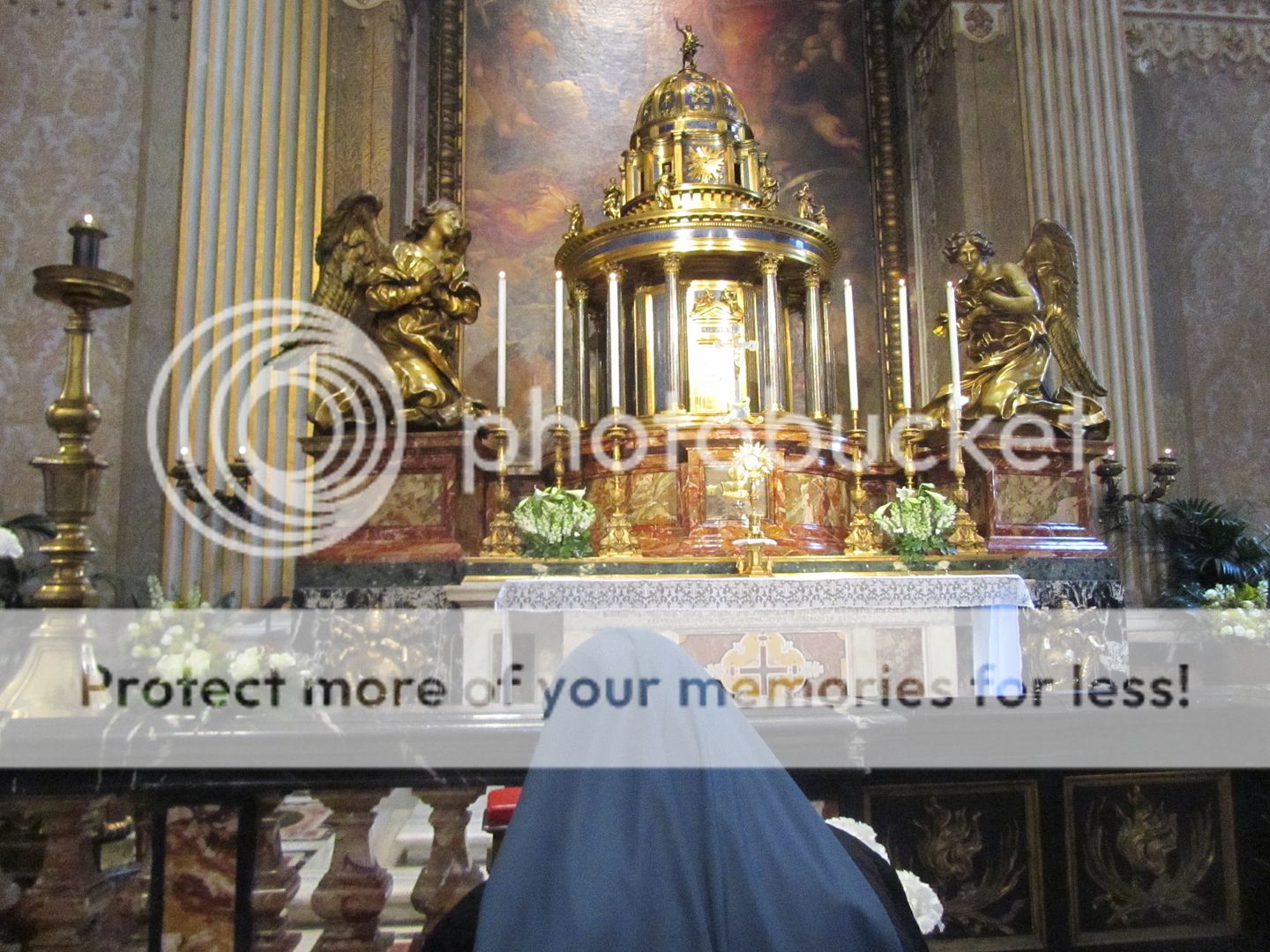So, really, what is your feeling about lace peeking out from under the chausible? Are you in mid-meltdown because noble vestments meant to showcase the Kingship and glory of Christ may take a backseat in Pope Francis’ bus while the plainer stuff, equally valid for liturgy but emphasizing Christ’s humanity, gets used?
Scripture tells us “to everything there is a season”. In a very complicated age, when the church has an awful lot of housecleaning to do, perhaps it is a season of simple dress. One does not wear finery while scrubbing the floors and mucking out the stables.
There is nothing wrong with simplicity. My regard for His Holiness the Pope Emeritus cannot be doubted; he is forever my dear Papa, but I frankly won’t miss the fusty gear, which often seemed to bury him. I liked him best in his plain papal whites.
Father Dwight Longenecker, noting the unhappiness of the bling-and-Latin crowd analyzes it a bit:
In the developing world…[informal liturgical styles do not] necessarily carry all the baggage it does here. Just because a priest, bishop or pope is a bit more informal in his style of celebrating doesn’t mean he is a theological liberal or will compromise the faith. Indeed, everything about Pope Francis indicates that he is not only completely orthodox in theology and moral teaching, but that he has suffered for being so.
What strikes me about Pope Francis so far is that he celebrates Mass reverently and beautifully, but that his simplicity of life and his example of poverty means that he may not be as concerned about the “finer things” in Catholic worship. That doesn’t mean he’s going to ban everything that is beautiful, sacred and reverent. The give back with his informal style is that his preaching is heart felt and immediate.
But while there is nothing wrong with simplicity, elaboration is not something despicable, either. I like what Calah Alexander said tonight in a private chat:
We wouldn’t even know who Michelangelo was if it weren’t for the proud history of Catholics loving all kinds of bling. [Papal ornamentation] carries weight and meaning. But at this moment in history, when the first world is rolling in so much tasteless bling…I think we need a pope who’s willing to put away ornamentation and show the other side of Catholicism, the side [the bling-ed out world] would never take the time to search out, the plain pectoral cross, public transit, feet-washing side. It is kind of scary for Catholics, because we’re used to seeing that in Franciscans, but not in the pope. It really sort of turns everything upside down. [People are] not shallow for being unnerved by it.
Yesterday, I attended a Mass here in this Roman convent chapel, one in which about 100 young men and women participated. They were all nicely, if casually, dressed and their Novus Ordo worship was reverent and attentive. They sang a cappella, with neither organ nor guitar and sounded angelic in their harmonies. It was one of the most beautifully solemn and prayerful masses I’d ever attended, and it was as simple as it gets. No one attending it could have found it lacking in either instruction or transcendence. I thought to myself that if we ever reach a point where masses are once again covert celebrations, with priests traveling light, and instruments unavailable, we would still have a measure of beauty before us. And, more importantly, the Eucharist.
Because it is true that a mass can be both simple and tremendous, it’s easy to feel like the rad-trad hand-wringing over form and fabric is excessive, and to an extent I do feel that way. Making a sartorial martyr out of Monsignor Guido Marini, the Master of Papal Ceremonies — who has not been dismissed and will be in charge of 14 Franciscan Friars during the Papal Installation — strikes me as something Marini could not like, himself.
All that said, I do understand the fear that is driving some of this reaction, and it’s not really about the vestments; it is a fear that having, in their view, managed an escape from the land of clown-and-puppet liturgies thanks to Summorum Pontificum, this new era of simplicity might find that refuge taken from them.
Absurdists liturgies have more or less disappeared, but even so, I don’t think that will happen. I’ve written before that the win/win of Summorum Pontificum was that it would strengthen all of the liturgical forms:
It may restore some equilibrium to those self-indulgent liturgists who have come to believe that any old thing they can come up with must be a better option than what worked for 2,000 years. A return to seriousness and an appreciation of what came before could help strengthen liturgy that has been too long unsettled (and as the liturgy goes, so goes the worship).
Pope Francis means to be a reformer, but Benedict was, as well. Our popes are looking to strike balances in a world that is extremely disoriented and out-of-whack. By hewing diverse liturgical pathways, Benedict created a paradoxical means of Christian unity; all forms lead to Rome and to Heart of Christ. It’s too early to know yet, but I suspect Francis is going to use the message of mercy to help more people access those roads. If so, this the hermeneutic of continuity, more or less on steroids.
The most hopeful thing about Francis, to my way of thinking, is that he is not anyone’s man but Christ’s. He will continue to defy labeling (and cause suspicious thinkers to suspect him from both “left” and “right”) while preaching Christ Crucified and his mercy, as did his predecessors; not with the philosophical depth of John Paul II, nor with the theological nuance of Benedict but with the zeal and outreach of a troubadour and the defiance of an apostle.
Which means he will always be a burr in someone’s butt. Signs of contradiction usually are. Adjust.
ADDENDUM: Speaking of adjustments, as Lisa Graas points out, joy over Francis should not be regarded as an automatic critique of Benedict — they are wholly different men, differently called by the same Spirit — but some (like the increasingly spiteful-and-adolescent sounding Cardinal, who has some brass crowing about extravgance considering the money he spent building one of the ugliest cathedrals in Christendom) are inflicting real pain in some corners by hinting that this difference in style is Francis’ personal rebuke to and repudiation of Benedict’s papacy. They apparently do not realize that by projecting their bitter feelings on to Francis they draw an unhelpful and ungenerous portrait of our new pope, who doesn’t seem like he would be so unkind, or so subtle. They’re making a period of adjustment more difficult than it ever needs to be.
UPDATE: While this blogger and I are not on the same page, I think she makes a point worth noting:
That Pope Francis is personally humble and a gifted preacher is certainly wonderful and quite a positive thing. Humility is a gift to which all of us should aspire to attain. However, it would be a total misreading of St. Francis’ reform if we were to take humility to the extreme and strip the Holy Sacrifice of the Mass of its beauty, grandeur and sublime majesty. The holy deacon once said that “Lady Poverty should never enter the sanctuary.
Nor did Jesus refuse the expensive nard, either. Balance. We are seeking balance. The barque of Peter has been roiled for a solid decade. Balance will come, but the wheel is going to have to spin a bit for us to find it.
UPDATE: Here is the Libretto for tomorrow’s installation liturgy (mega-pdf)












